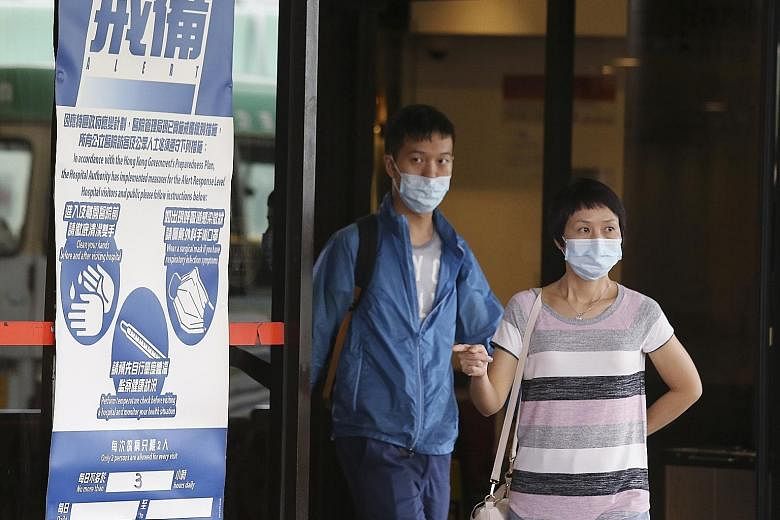HONG KONG • Public hospitals in Hong Kong are struggling with an unusually long flu outbreak that has killed more than 200 people since May.
In the first two weeks of this month, "some 1,000 patients needed to be admitted to general medical wards of public hospitals every day", the South China Morning Post (SCMP) reported, quoting Dr Cheung Wai Lun, the director of Cluster Services of Hong Kong's Hospital Authority.
"Usually, such a situation would last about two or three days and we would be able to cope with it. But this year, it lasted for more than 10 days," he said.
As a result, the workload at public hospitals has increased, with occupancy rates at medical wards above 100 per cent since last Monday, the Hong Kong newspaper reported.
On Sunday alone, 5,562 people turned up at the accident and emergency departments of mainstream public hospitals. Of those, 831 were warded, pushing up the occupancy rate to 110 per cent of capacity.
The weekly number of severe cases also jumped in the second half of last month - from 17 to 33 - said SCMP, quoting official figures. There were no severe cases reported in the same period last year.
Since May, a total of 205 adults - many of them elderly - and three children have died from the flu.
Views on whether the flu virus in the current outbreak is mutating are divided.
Dr Paul Chan, a microbiologist at Chinese University, told SCMP that he believed the outbreak is partly because the flu vaccine given in November last year had started to expire.
The summer outbreak could also be due to a weaker flu peak last winter, said Dr Leung Chi Chiu, chairman of the Medical Association's Advisory Committee on Communicable Diseases.
As a result, the number of people who have developed natural immunity would be smaller. This might also explain why more people are ill now, he said.
Others, however, feel that a mutation in a dominant flu strain might be the cause of the current crisis.
Top infectious diseases expert Yuen Kwok Yung, from the University of Hong Kong's microbiology department, said that the dominant influenza A H3N2 might have mutated in a such a way that vaccines used in the past two years have become ineffective.
The crunch at public hospitals is so bad that some patients reportedly waited for more than 12 hours to get admitted.
Patients whose conditions were not life-threatening had to wait at least six hours to see a doctor, according to SCMP.
Last Sunday, the city's Chief Executive Carrie Lam called on the Hospital Authority to come up with urgent measures to deal with the crisis. She made the request after visiting Queen Elizabeth Hospital in Yau Ma Tei, one of the public hospitals facing the squeeze.
The Hospital Authority subsequently announced that it will rope in private hospitals to help ease the crunch.
For a start, it will be spending HK$20 million (S$3.5 million) for 48 extra beds at a private institution in the next two months, according to SCMP.
The Hospital Authority plans to buy bed services from the private St Teresa's Hospital for Queen Elizabeth Hospital patients who urgently need a bed. They will pay the same rate charged by public hospitals - HK$120 a day.
Other private hospitals have also expressed interest in offering help.
The Hospital Authority said it hopes that the 100 newly graduated doctors later this month would help ease the manpower crunch at public hospitals. Up to 2,000 nurses will also be injected into the system by September.
Meanwhile, hospitals will hire more part-time doctors and ask nurses who are on leave to return to work, according to SCMP.
The Medical Association, the largest doctors' group, has also urged private doctors and retired doctors to offer their time on a part-time basis at public hospitals during the crisis.
Primary health care in Hong Kong is mainly provided by private general practitioners (56.8 per cent). The rest comes from mainstream public hospitals and traditional Chinese medicine (TCM) practitioners.
Yesterday, The Standard newspaper reported that the city's 18 government-supported TCM clinics could see up to 30 per cent more patients each day.
Professor Chen Wei, chief of Yan Chai Hospital's Chinese medicine service, told The Standard that the spike in flu cases this summer is related to the hot and humid weather, which causes heat and dampness in the body.
Vulnerable groups such as the elderly and young children are advised to see a doctor as soon as they fall sick, Dr Leung of the Medical Association told SCMP.

